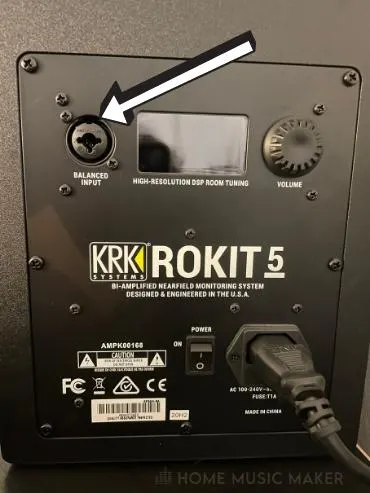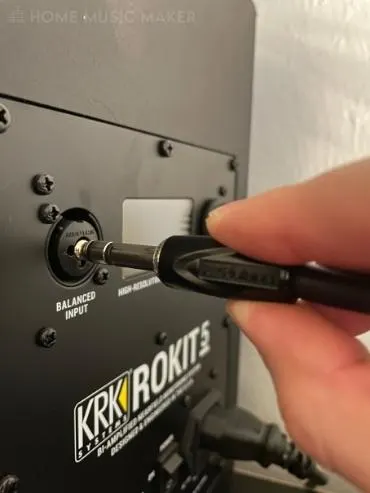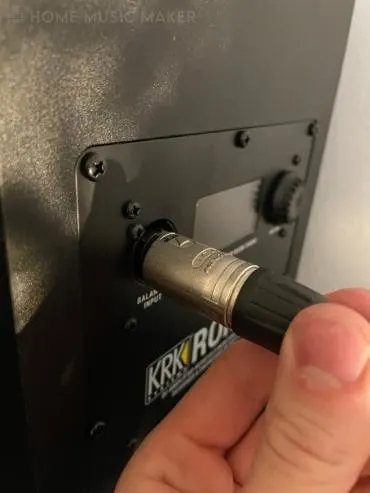The cables that you need to connect KRK Rokit 5 studio monitors to your audio interface are either balanced ¼ inch TRS male cables or balanced XLR male cables. Because the inputs on your KRK monitors are both ¼ inch and XLR compatible, you have some flexibility when choosing cables.
Proper Cables For Your KRK Rokit 5 G4 Monitors
Using the proper cables is crucial for your KRK studio monitors’ audio quality and longevity.
If you do not use the correct type of cables to connect your Rokit 5s, this will drastically reduce sound quality and can also damage your monitors.
With so many different types of inputs and outputs in the world of audio production, it can be hard to know what kind of cable you need sometimes.
In this in-depth guide, I will show you what cables you need for your KRK Rokits.
Using Balanced Cables
When connecting your KRK monitors, the main thing to pay attention to is that you use balanced cables.
KRK Rokit 5 studio monitors have balanced inputs, so you should not use them with unbalanced cables.

Balanced cables are also less susceptible to noise interference and distortion, which means they have better sound quality than unbalanced cables, so always ensure you use balanced cables.
What Connector Type Do I Need For My KRK Rokit 5’s
When looking for cables for your Rokits, the next thing to consider is what type of connectors they need.
The KRK Rokit 5’s balanced input can accept both ¼ inch and XLR connectors, so you can use either type to connect to your studio monitors.
The other connector you need depends on the outputs of your audio interface.
Most audio interfaces have either ¼ inch or XLR outputs, which are two widespread cable types.
If your audio interface has ¼ inch monitor outputs, I recommend that you choose these cables.

If your audio interface has XLR monitor outputs, I recommend that you choose these cables.

If you do not have an audio interface, I recommend choosing this cable to connect your KRK Rokit 5 studio monitors directly to your computer or laptop.
The fact that KRK Rokit 5s can accept both ¼ inch and XLR cables gives you freedom when choosing cables.
Reliable Cable Manufacturers
We want to look at the last thing when choosing cables for our Rokit 5 monitors is which manufacturer to buy from.
When it comes to buying audio gear, it’s essential to buy quality gear that will last you a long time.
Don’t waste your money on cables that are not high quality and long-lasting.
Here is a list of a few manufacturers of cables that I personally trust:
- Roland (I’m currently using Roland monitor cables)
- Hosa
- Mugteeve
- Dremake
Although there are dozens of companies that you can get monitor cables from, just make sure to only buy them from trusted sources and companies that you have heard of.
Using low-quality cables can result in audio interferences, distortion, and damaged equipment.
Related Questions
How Do You Connect KRK Rokit 5 Studio Monitors Directly to Your Laptop?
Because computers typically do not have any ¼ inch or XLR audio jacks. The best way to connect studio monitors directly to your computer or laptop is by using a 3.5 mm to dual XLR cable.
You can plug the 3.5 mm jack into your laptop/computer and connect the dual XLR ends to your KRK Rokit 5s.
What Does TRS Stand for In the Context of Audio Cables?
TRS stands for Tip, Ring, and Sleeve and refers to a type of ¼ inch audio cable made up of three main parts.
You can tell a standard ¼ inch instrument cable apart from a ¼ inch TRS cable because a TRS cable has two black rings on the tips instead of just one.
Although instrument and TRS ¼ inch cables look almost identical, they are both used for different purposes in music production.
How Much Should I Spend on Studio Monitor Cables?
You want cables that last you a lifetime in music production, so it’s best not to cut corners.
A high-quality and long-lasting studio monitor cable should run you anywhere from thirty to sixty dollars. However, depending on the type of monitors you are using, cables can be even more expensive than this.
Also, avoid buying cables from companies you have never heard of or don’t trust. It’s best to stick with well-known and reliable manufacturers.
What Are the Most Common Types of Audio Connections?
Some of the most common types of audio connections are:
– ¼ inch (think guitar and instrument cables)
– XLR (think microphone and some speaker cables)
– 3.5 mm (think of a headphone jack on a phone or laptop)
Although there are many other types of audio jacks and connections in music production, these are the three most common that you see, especially as a beginner.
What Is the Difference Between a Powered Studio Monitor and A Passive Studio Monitor?
A powered studio monitor, also known as an active studio monitor, is a self-powered speaker. It has a power amplifier inside of it that allows you to plug the monitor speaker directly into a wall outlet.
However, a passive studio monitor needs a separate power amplifier to run.
How Can I Fine Tune my KRK Rokit 5 Studio Monitors to My Own Studio?
The best way to set up and fine-tune your KRK Rokit 5 monitor speakers is by using the KRK app.
The KRK app has different tools that will help you place your studio monitors and fine-tune them to match the acoustics of your room.
You can find the KRK app on the app store by searching KRK Audio Tools. Also, KRK Audio Tools is a free app!
Final Words
As I have shown you, you must use the correct cables when connecting KRK Rokit 5 studio monitors and any other audio gear, for that matter.
Using incorrect cables in audio production will result in damaged equipment and poor sound quality.
Although there are plenty of choices for speaker cables that you can go with, just make sure that you only use balanced cables!
Make sure to also check out this article for an in-depth look at how to set up KRK Rokit 5 studio monitors.

 Want to connect with other music producers for help and guidance?
Want to connect with other music producers for help and guidance?
Mae
Tuesday 18th of July 2023
Hi thanks so much this is really helpful info. I have a couple questions still and wonder if you might be able to help. I have these:
Monitors: KRK Systems Rokit RP5 G4 Mixer: Mackie ProFX6v3 (output for mixer: https://www.manua.ls/mackie/profx6v3/manual?p=8)
So I have the two options for the rokits (XLR and 1/4in TRS) and I have two options for the Mackie mixer (XLR 'female' and 1/4in TRS)... what combination of input/outputs would be the best?
I'm not clear on if XLR are always better when it is an option, but that's what I'm gathering, perhaps more stable also since it can't spin?
Basically I was thinking an XLR male - XLR female would be best for my rokit to mackie. You didn't make any suggestions for this kind of scenario and I'm struggling to find info online about this.
I found these from Roland: Roland RMC-G10 Gold Series Microphone Cable or Roland Black Series Heavy-Duty XLR to XLR Balanced Microphone Cable
I think they are both balanced the gold is more expensive, I think since it has the neutrik. They are described as microphone cables everyone so I'm worried to buy them for monitor to mixer usage but should be fine ? Any advice?
Thank you! Mae
Matt
Tuesday 18th of July 2023
Hi Mae,
Thanks for reaching out. I'm glad the information I provided was helpful.
To answer your question about the best combination of input/outputs for your Rokits and Mackie mixer, I recommend XLR male to XLR female.
This is because XLR connections are balanced, making them less susceptible to noise interference. XLR cables are more durable than TRS cables, making them less likely to be damaged.
Here are the steps on how to connect your monitors to your Mackie mixer using XLR cables: Connect the XLR male connector from the first Rokit monitor to the XLR female connector on the first input channel on the mixer. Connect the XLR male connector from the second Rokit monitor to the XLR female connector on the second input channel on the mixer. Turn on the mixer and the Rokit monitors. Adjust the volume levels on the mixer and the Rokit monitors until you are satisfied with the sound.
I hope this helps!
You mentioned being interested in the Roland RMC-G10 Gold Series and the Roland Black Series Heavy-Duty XLR to XLR Balanced Mic Cable.
Both cables are balanced, so they will provide the same level of noise protection. However, the Roland Gold Series has a gold-plated Neutrik connector. This high-quality connector is less likely to corrode. The Roland cable has a black-plated Neutrik connector, is still high-quality and less expensive than the gold-plated connector.
Ultimately, the best cable for you depends on your budget and personal preferences. I recommend the Roland RMC-G10 Gold Series Microphone Cable if you want the best possible quality. However, if you are on a budget, the Roland Black Series Heavy-Duty XLR to XLR Balanced Microphone Cable is also a good option.
Cheers Matt